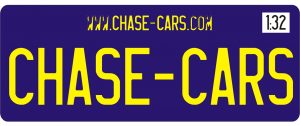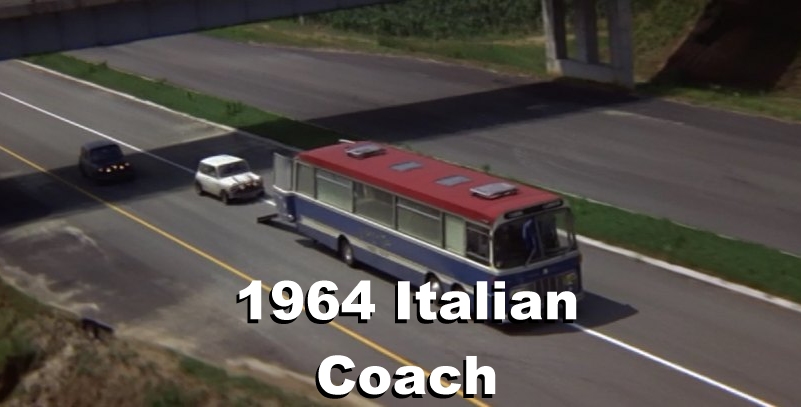
Say you were planning an ambitious gold heist, you’d need a cunning plan to steal the gold but really the clever bit is to plan the getaway. Small, nimble cars would be ideal to get the gold out of the city but you would want to transfer it to a larger vehicle for your escape. All the better if you didn’t have to park somewhere to do the transfer which would mean some fiendish way of loading.
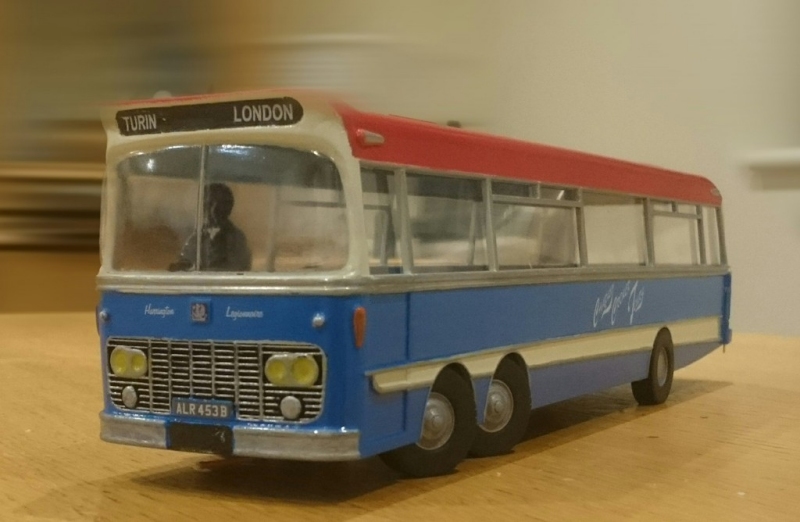
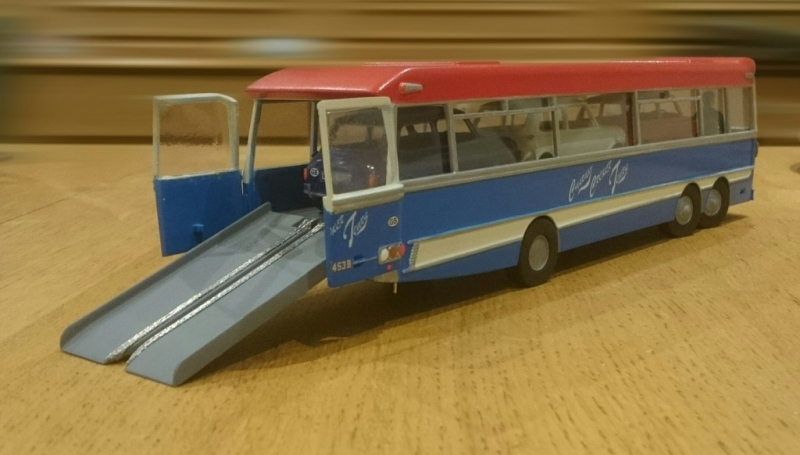
To get it to fit on a Scalextric track and still fit 3 Minis makes it a big vehicle, 340mm long and almost 80mm wide. The structure is a 3D printed bodyshell with removable floor, this accommodates the steering systems, motor pod and of course give somewhere for the Minis to ride.
The reason for the two front axles on the Harrington Legionnaire was one of pure penny-pinching. With the introduction of 36′ coaches in the UK, Bedford wanted a piece of the action but found it did not have a front axle of a heavy enough capacity in its TK range. Of course any other manufacturer would just engineer a heavier axle but Bedford only used components shared with its truck range to gain as much economy of scale as possible.
The answer was a simple one: by using three axles, no new axles would have to be created just for this one model. Initially twin rear axles were considered but tyre scrub was thought to be a big turn off for operators. Twin front axles were settled on using the axles from the TK with 16″ wheels and the first petrol powered chassis was completed (unofficially named lash up no.1) It was bodied by Duple with an elongated Vega style body and tested at Chaul End, Luton, to the point of destruction. This was before the test facility at Millbrook was opened in 1968! The body was still good and was transferred to a production chassis later on.
The front leaf springs were individually rated to give the bestf ride possible as Bedford did have a knack of good steel suspension design. The chassis had some interesting quirks. A blow out on one of the front axles did not severely affect the steering so it could be brought to a controlled stop with ease and this feature was demonstrated on film. The chassis also had two separate handbrakes. One was a transmission brake mounted on the input of the diff and another lever operated the brakes on the rear of the two front axles.
It was the first Bedford to be fitted from the factory with power steering. When launched, as Bedford didn’t produce a powerful enough Diesel engine, the Leyland 0350 was offered as the diesel option. This was different to the regular Leyland unit as the head was redesigned so that inlet and exhaust was on the same side of the engine. Eventually Bedord produced the 466ci engine and the Leyland option was dropped.
Initially finding favour with operators due to the extra axle and small wheels giving the impression of grater length so a VAL was seen by the public as futuristic and modern even though the design was somewhat of a compromise. After a few years the decision to use the lighter axles and small wheels was repaid by big problems with brake wear and balance and the steering geometry was fickle to eliminate high tyre wear in the faster wearing front tyres and the chassis quickly fell out of favour with operators. The brake wear problem was slightly helped with the introduction as an option of a Telma electric retarder and this was specified or retrofitted to many chassis.
The original reason for the six wheel layout was removed after a couple of years as a heavier axle was needed and indeed designed for the heavier weight TK models and so was available for bus and coach use. The Bedford VAM was designed using two axles and could be seen as the VALs replacement however the VAL carried on being sold until around 1973.
Back to the slot car! This is what you get in the kit. The only thing you need to supply is the motor, a long can type. I used a Ninco NC-2 but anything that’s got around 260g.cm of torque at 18000rpm will be fine, just make sure you get one with the short armature so the pinion fits as shown.
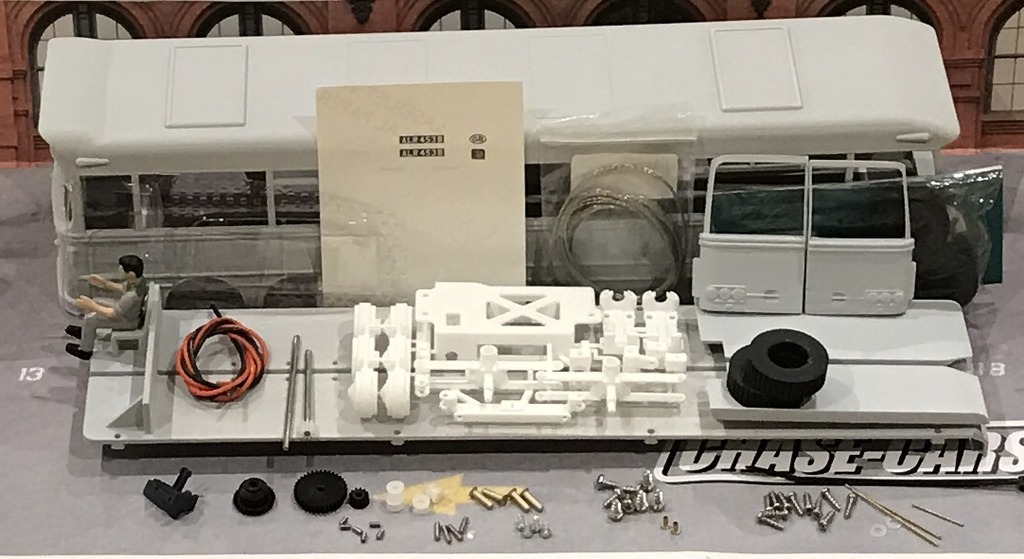
In the kit you get:
- 1 x Bodyshell
- 2 x Rear doors
- 1 x Floor
- 1 x Ramp
- 1 x SLS running gear kit
- 6 x Wheels
- 1 x Front and rear window set
- 2 x Side window set
- 1 x Waterslide graphics kit
- Braid
- 1 x Driver figure
- 6 x Tyres
- 1 x Red & Black silicone jacket wire
- 2 x Door hinge pins
- 1 x Guide
- 1 x Guide pin
- 2 x Guide ferrules
- 4 x Front stub axles
- 1 x Rear axle 65mm long
- 1 x Rear axle contrate gear
- 1 x Driven shaft with pinion 45mm long
- 1 x Gear reduction set
- 6 x 6mm stainless steel pins
- 1 x Cable tie
- 8 x Machine screws
- 9 x Bearings
- 15 x Running gear screws (2.5x8mm)
- 8 x Body mounting screws
- Enough braid or copper tape to do the inside
This is how the running gear is supplied, the components are on a sprue just like a model kit. Looks daunting but actually it’s easy, let’s get everything apart.
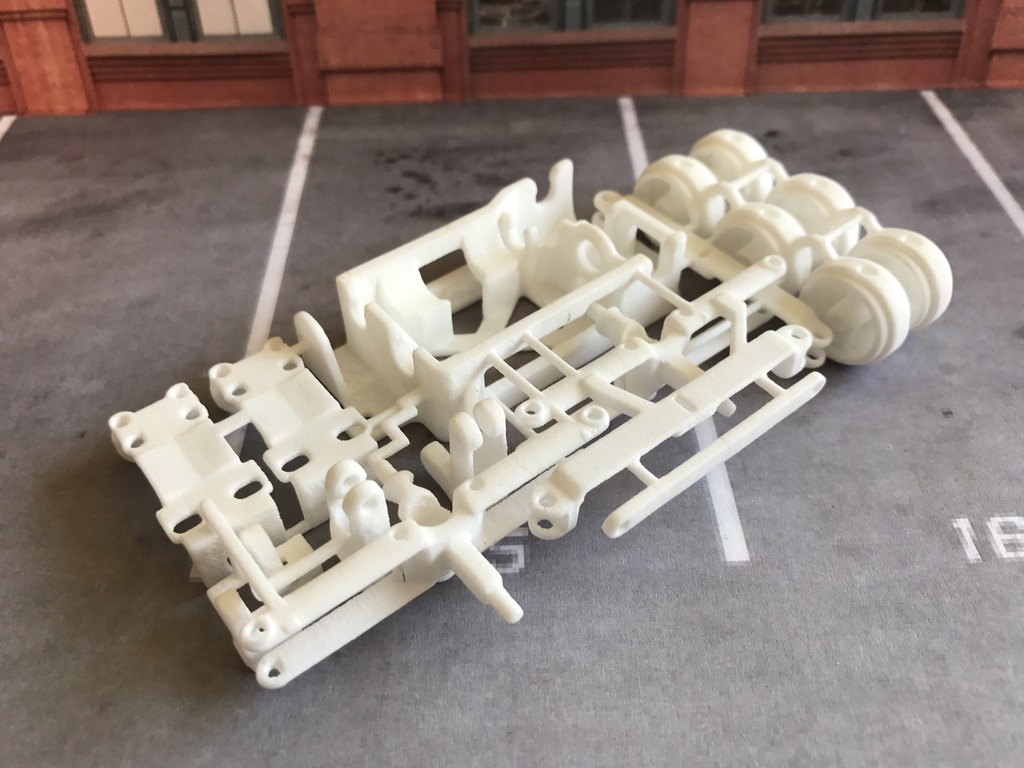
First, remove the wheels.
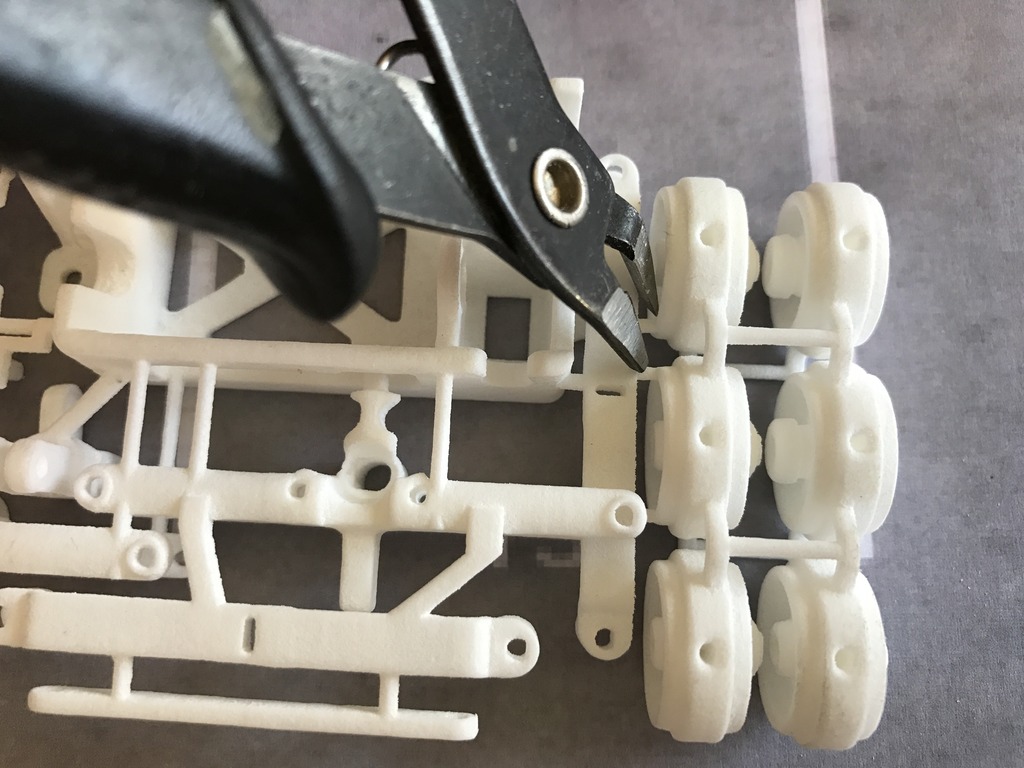
Next to the wheels is one of the steering linkages, remove that next.
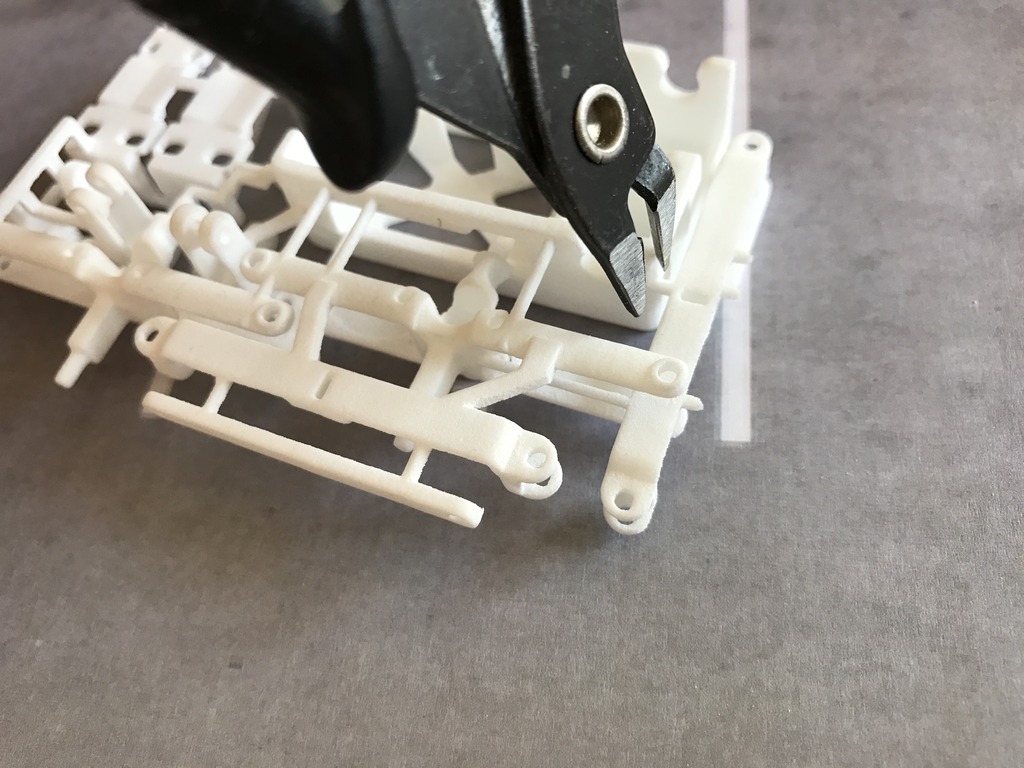
Then the other steering link. It’s got the tie-bar attached that goes between the two front axles.
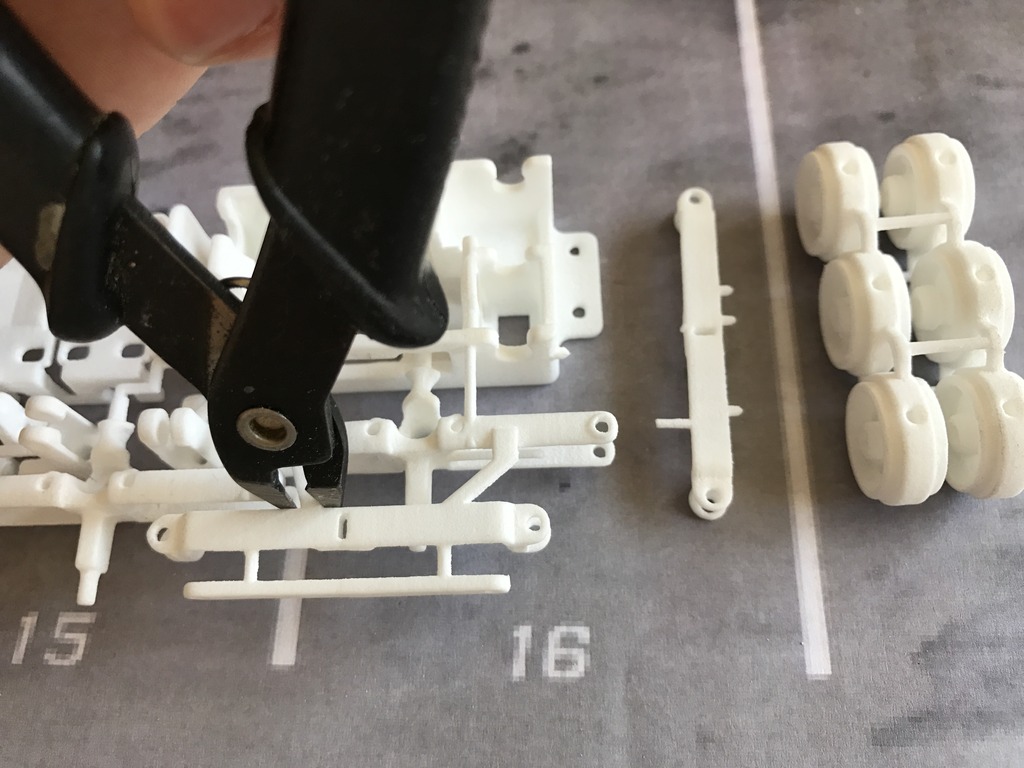
Next, the front axle.
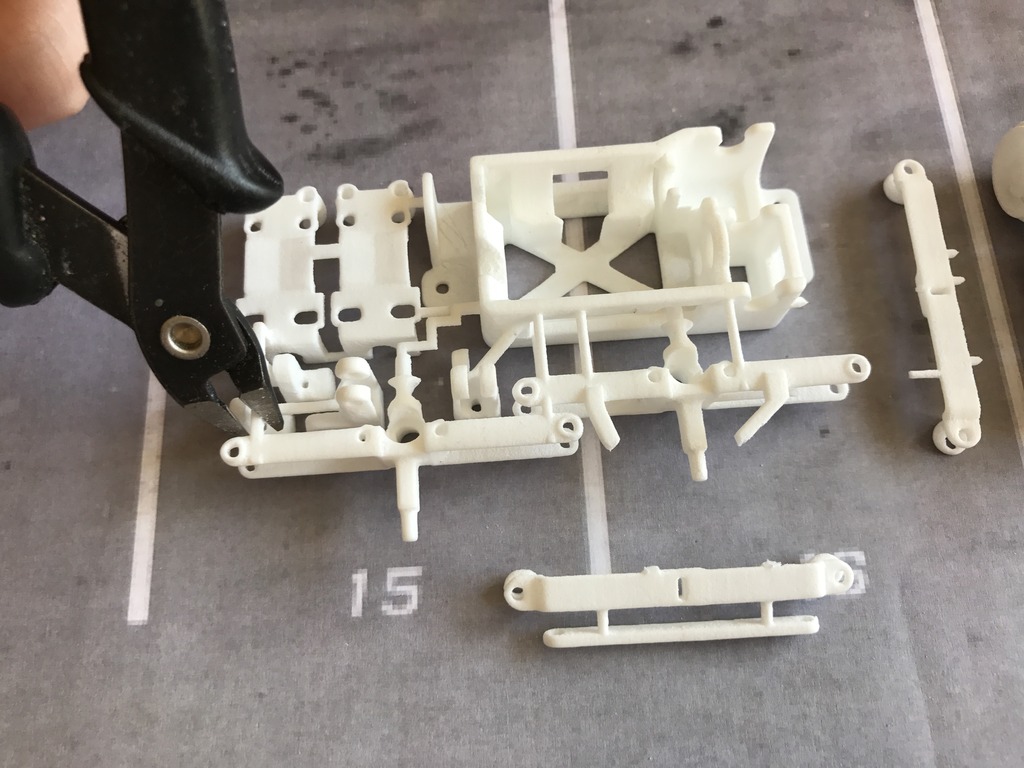
Then the other front axle.
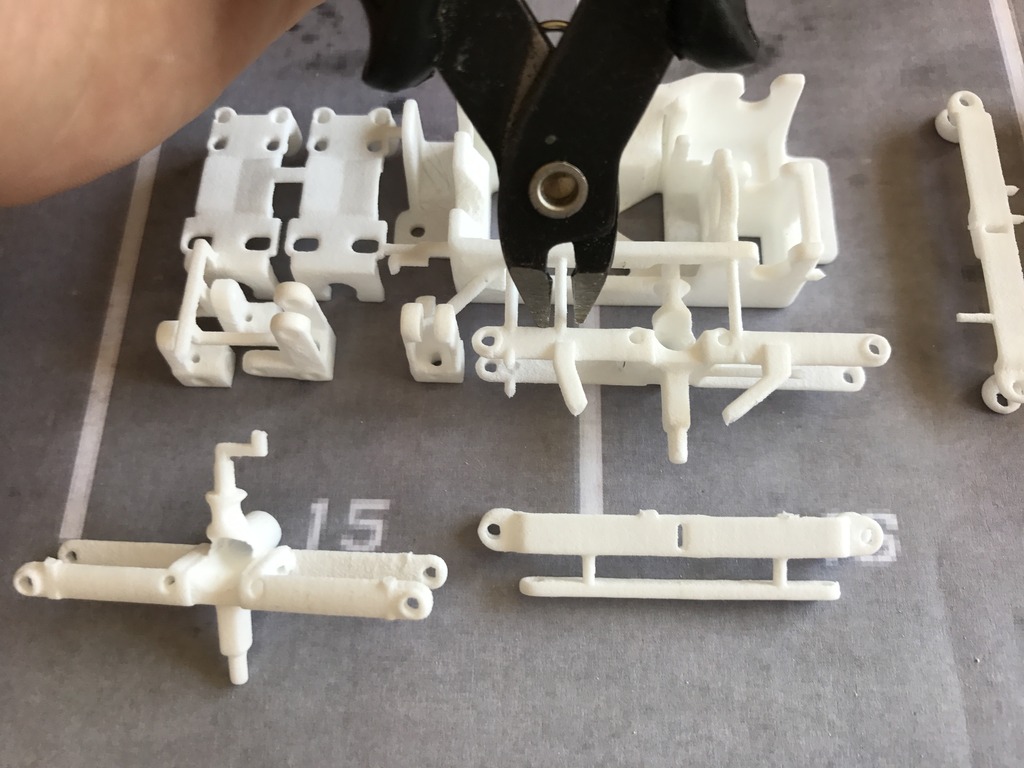
Now we’ll take off the hubs, there are 4 of course. Remove this one first.
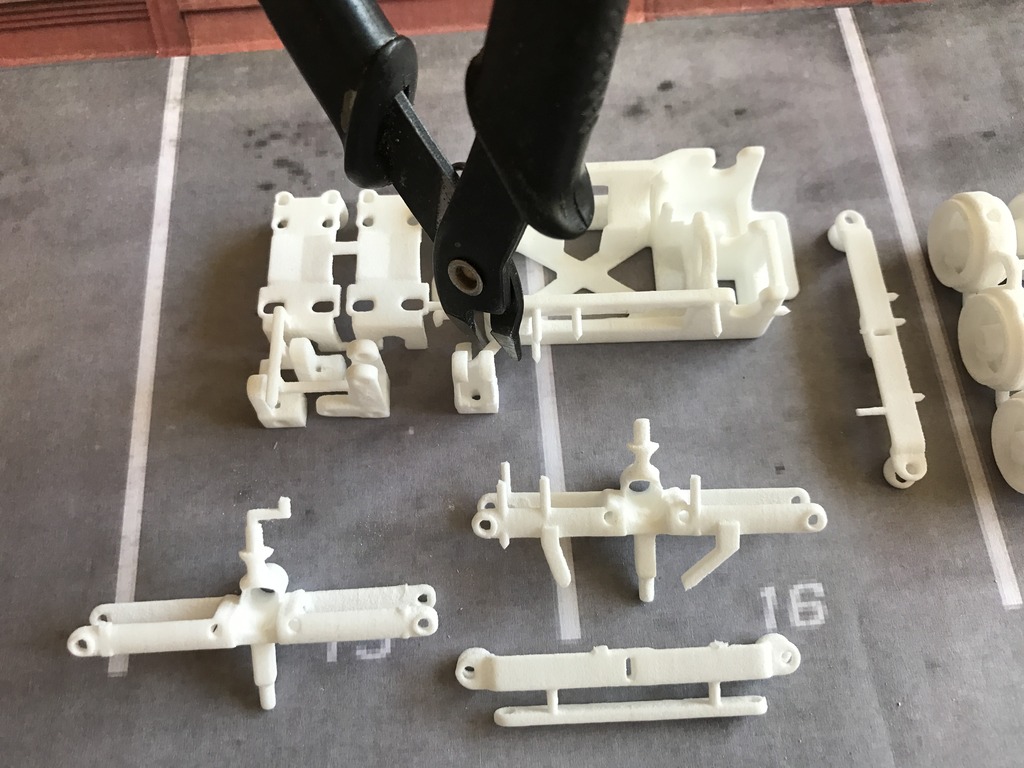
The other 3 can be removed as a group.
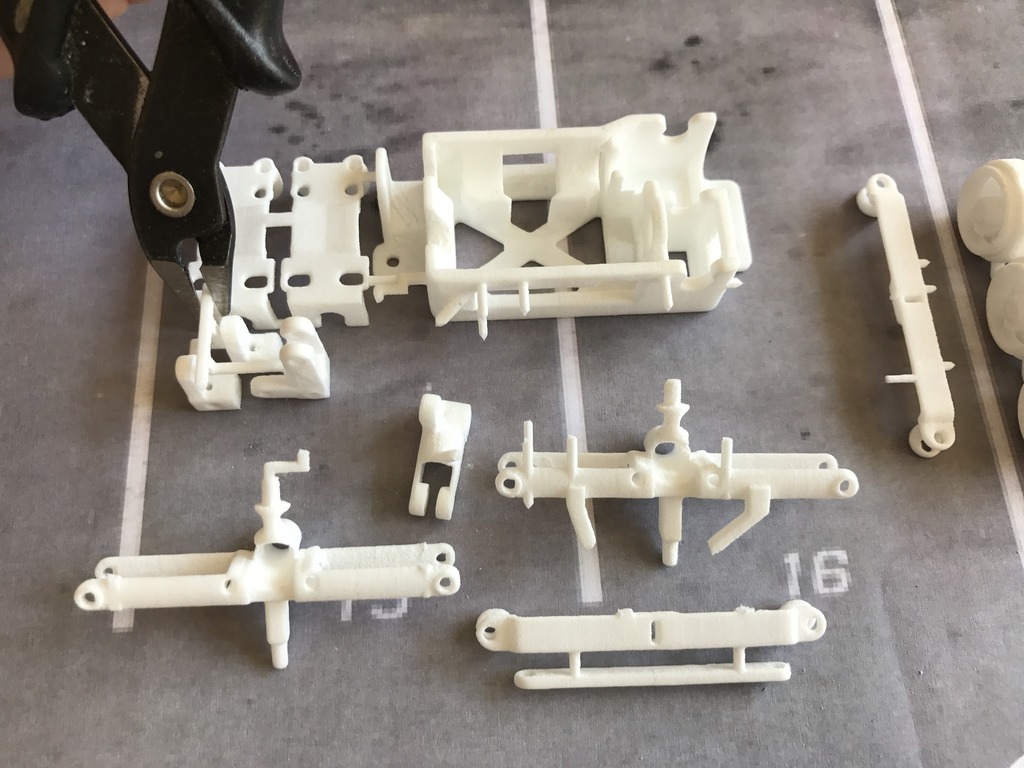
Now remove the two front axle supports and separate the hubs. You should have this…
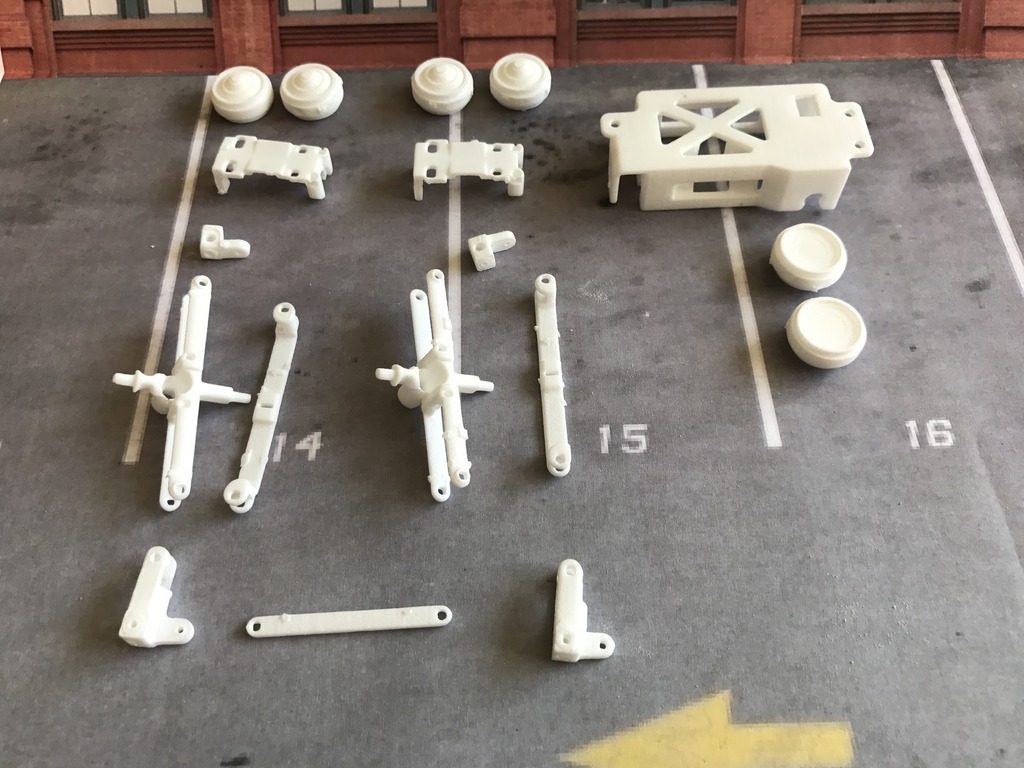
…and a load of tiny offcuts. Let’s get the parts cleaned up and all the SLS powder out.
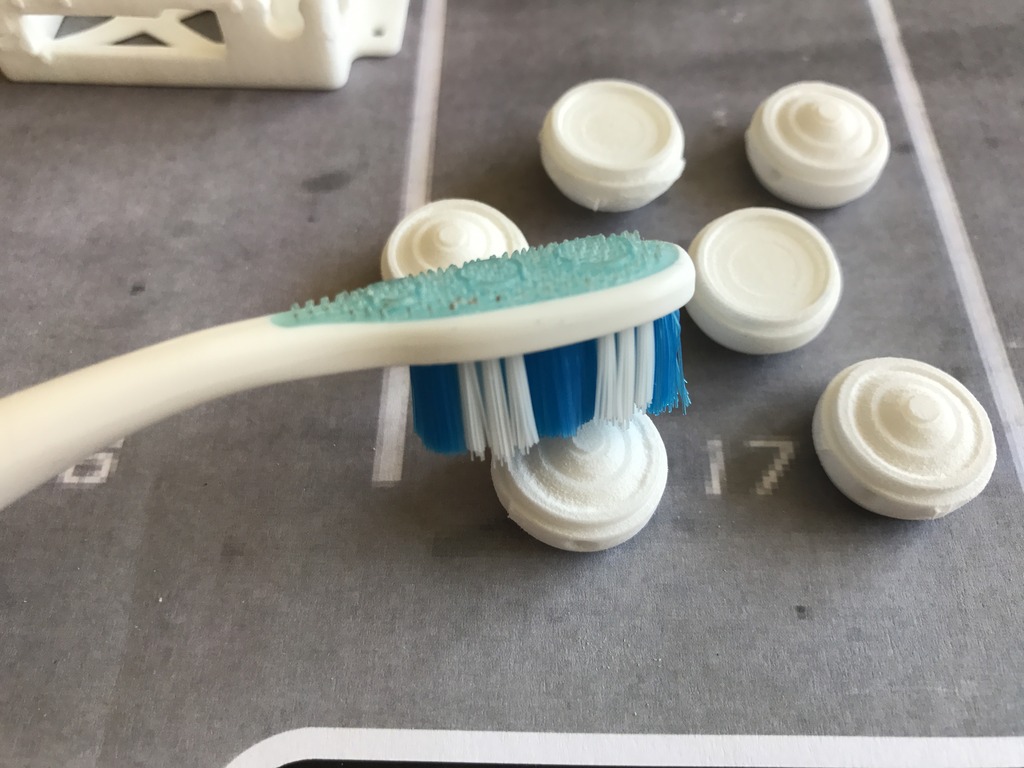
This should also be done already – clearance for the stub axles so they rotate freely. A 2.4mm drill bit should be fine.
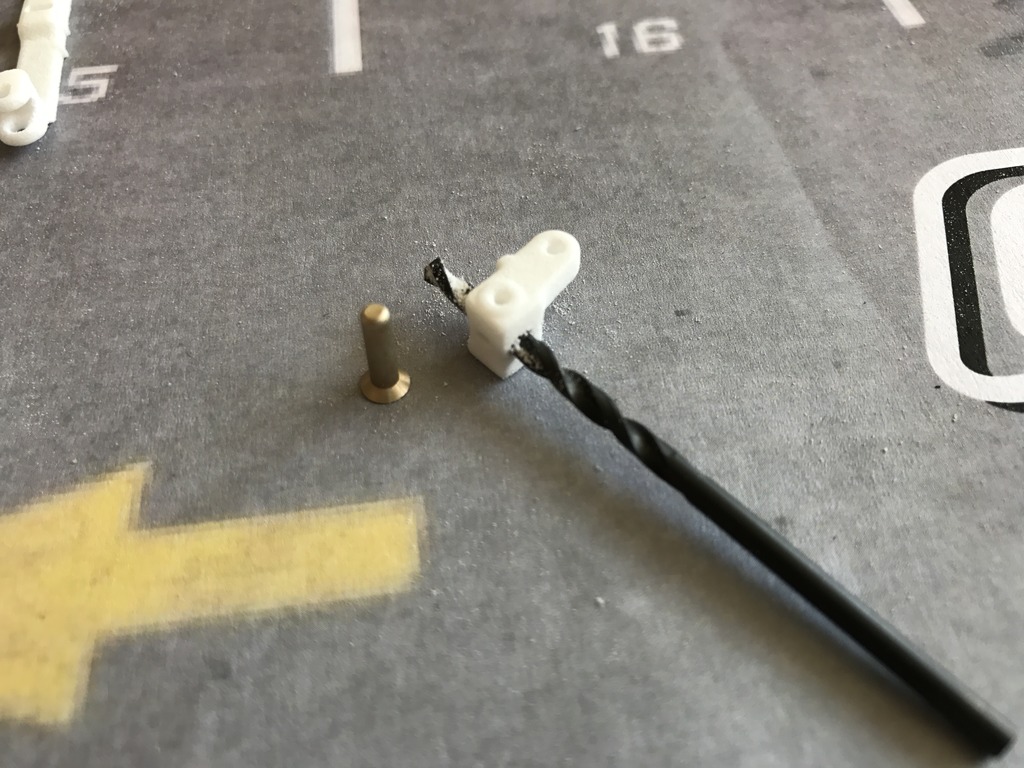
Use a 3/32″ reamer on the wheels so the axle is a snug fit. You can then glue the wheels on.
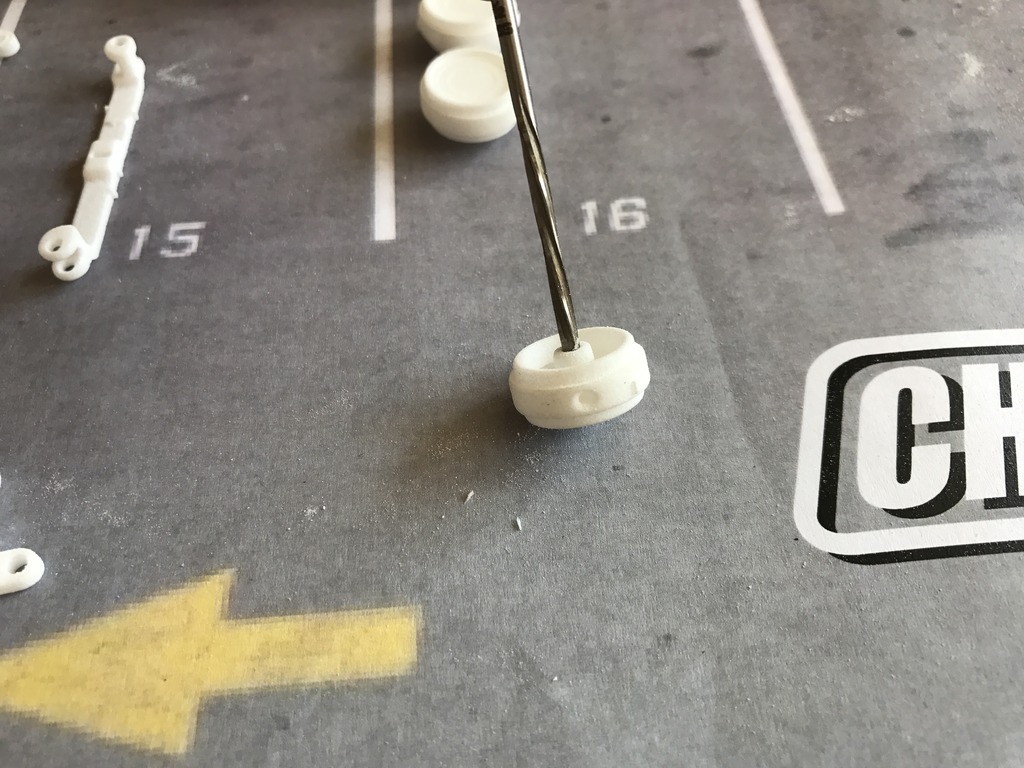
The stub axles fit this way, careful of the orientation!
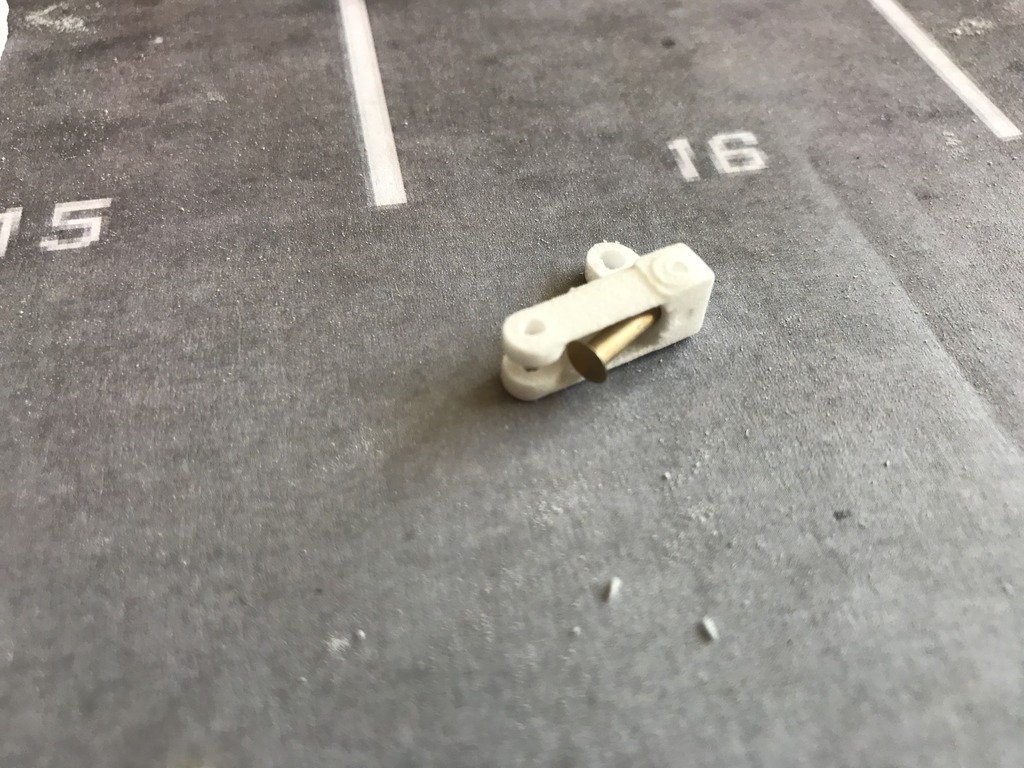
Then push the stub axles all the way through. They should rotate smoothly.
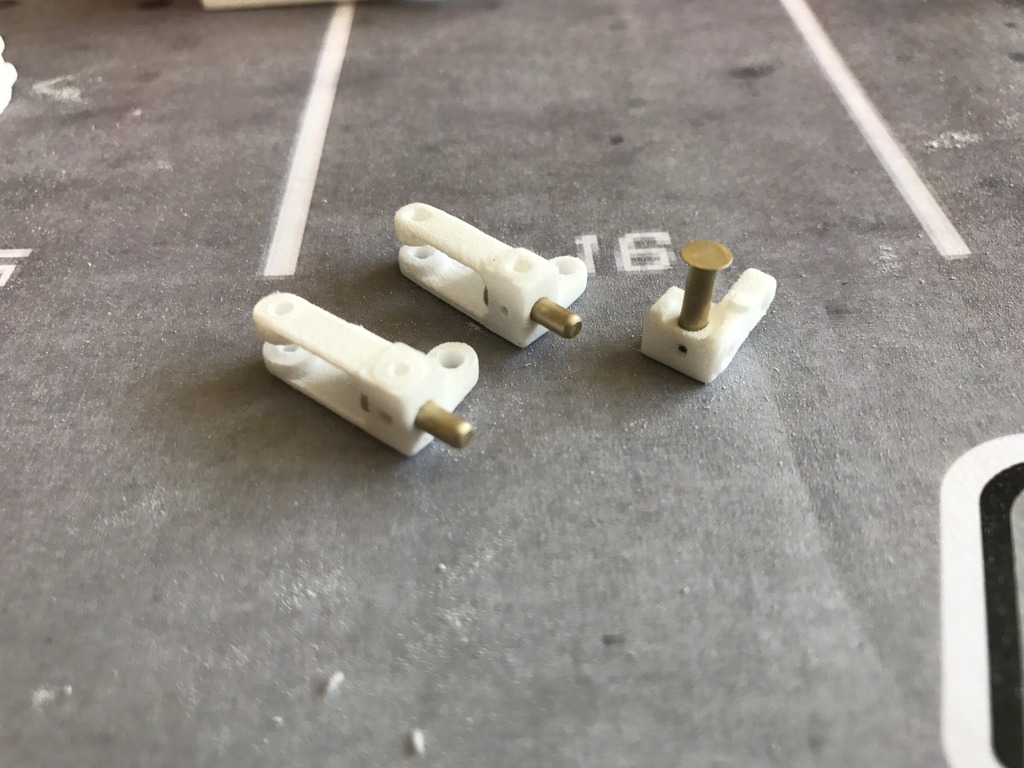
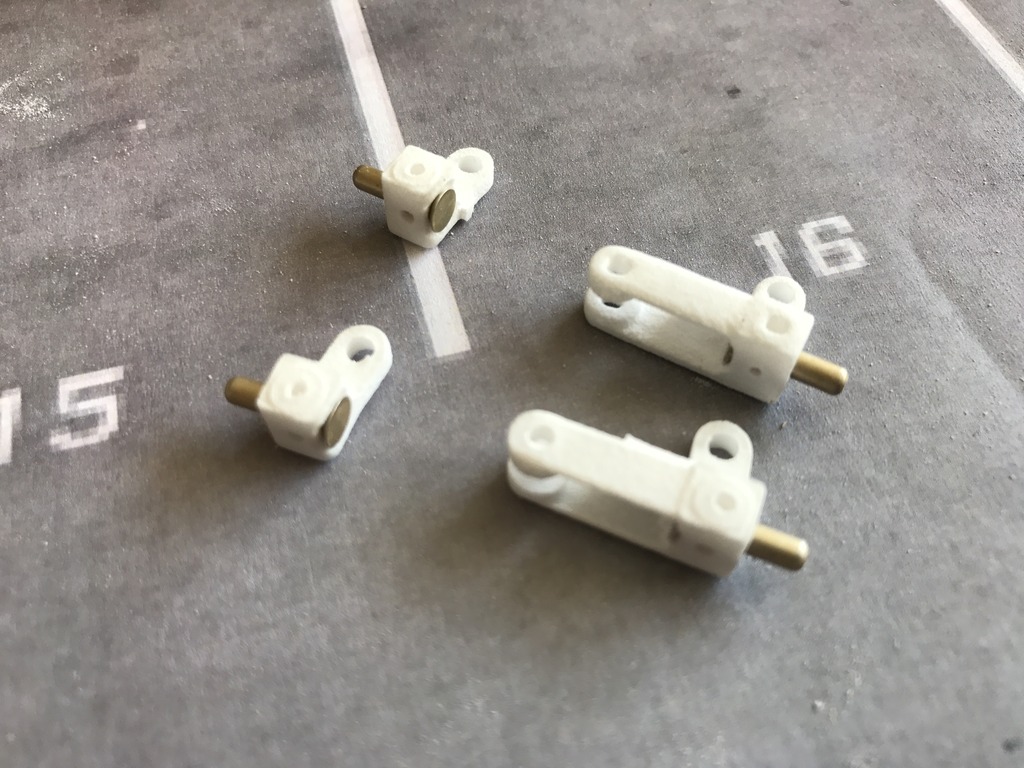
Build up the front axle as shown.
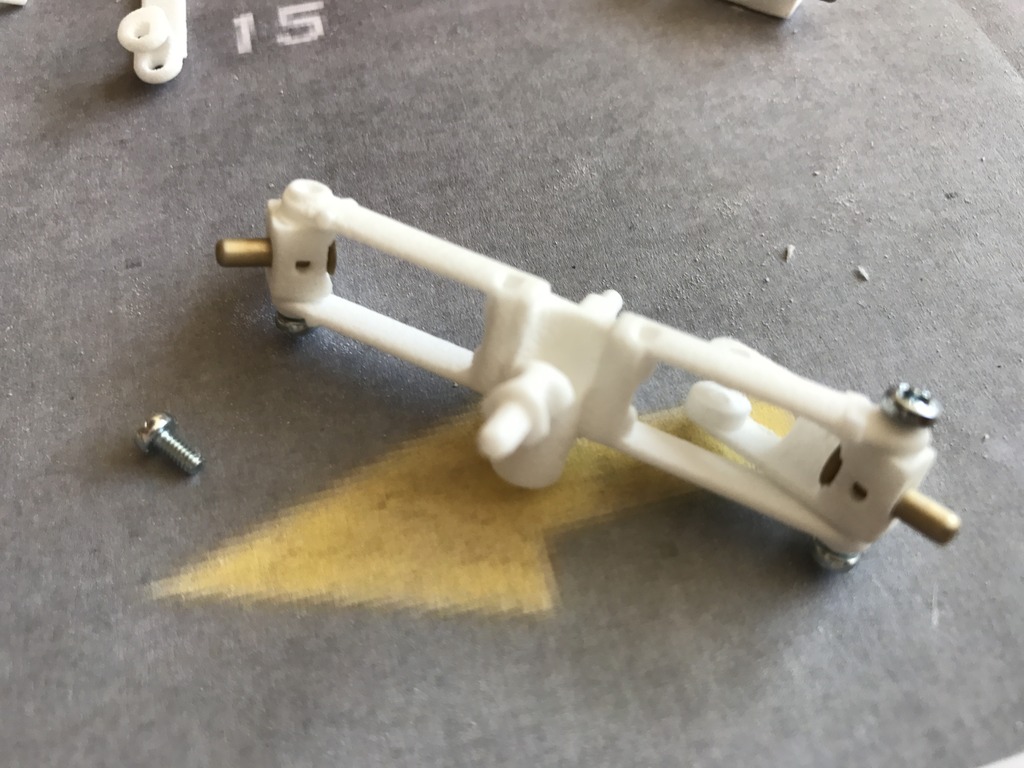
Take one of the roll pins and push it through the tie-bar.
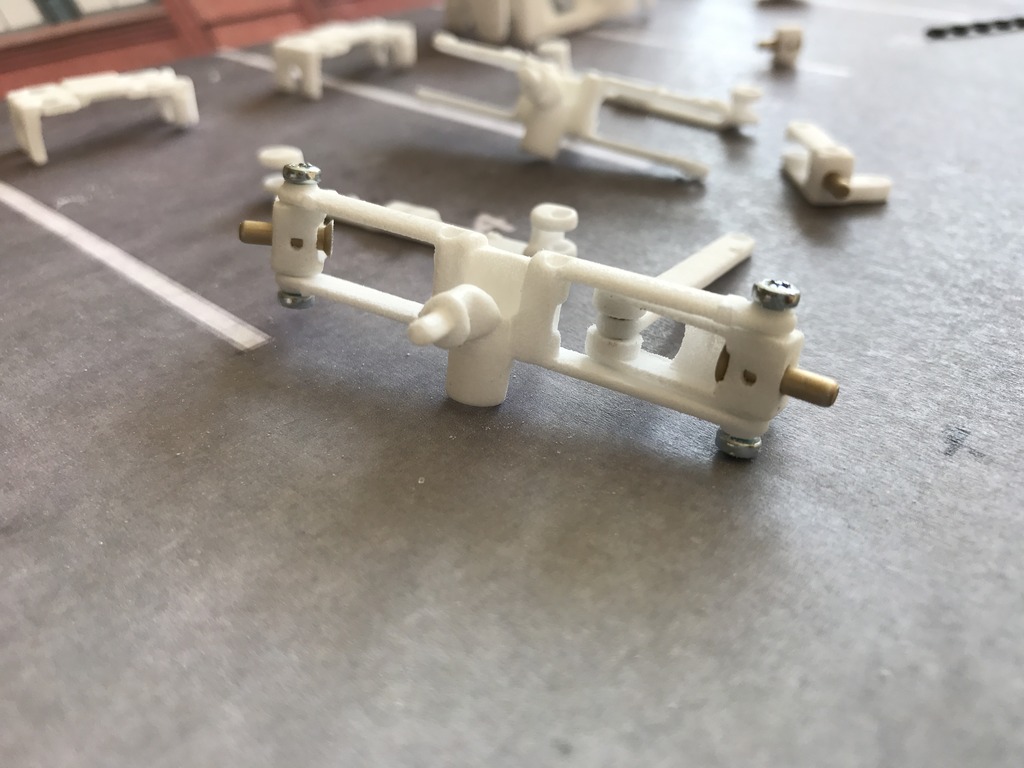
Build up the other axle and link them together.
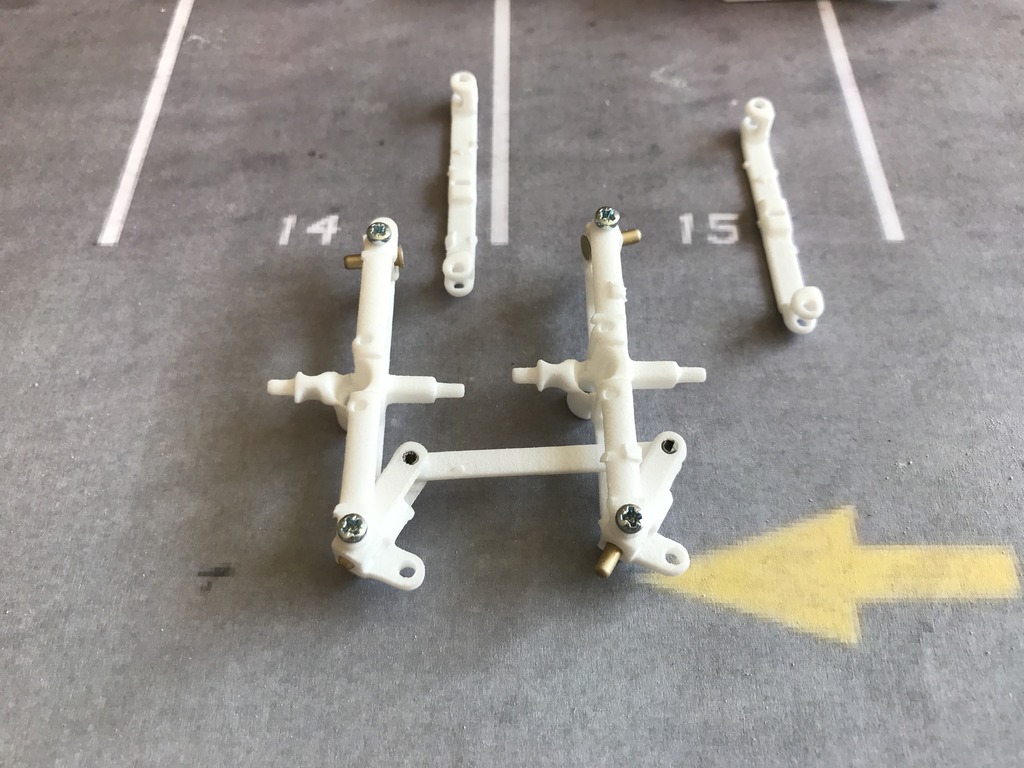
Put the roll pins through the steering linkage and fit to the stub axles. The ARROW should point forwards!
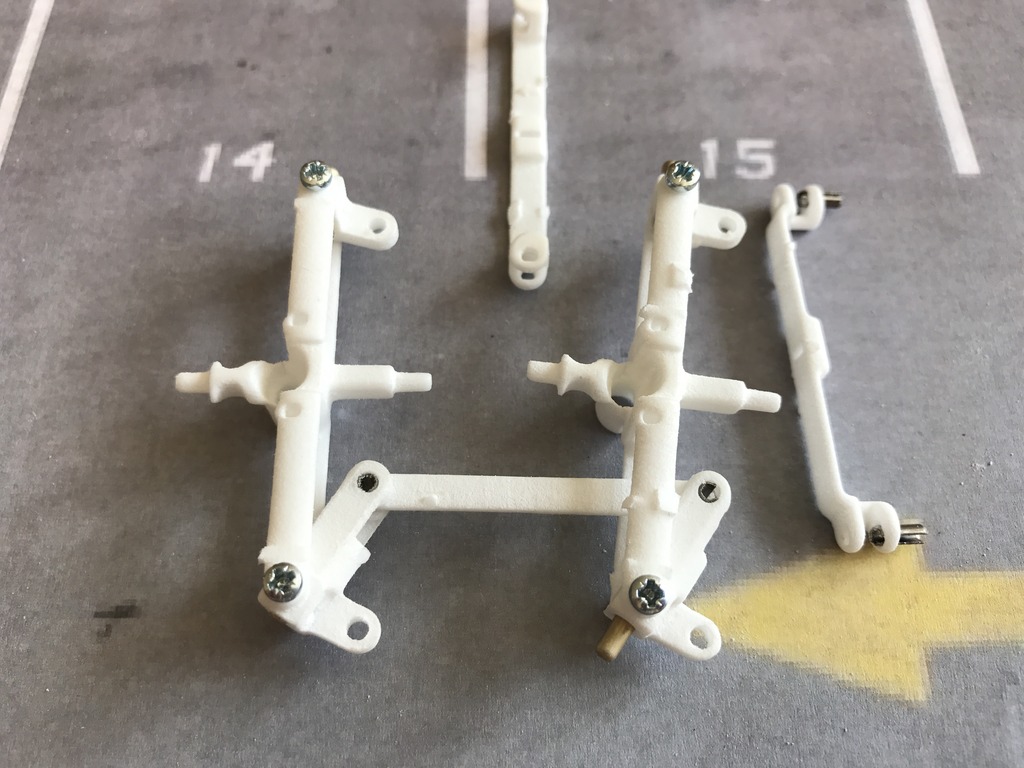
Squeeze into position. It should rotate freely.
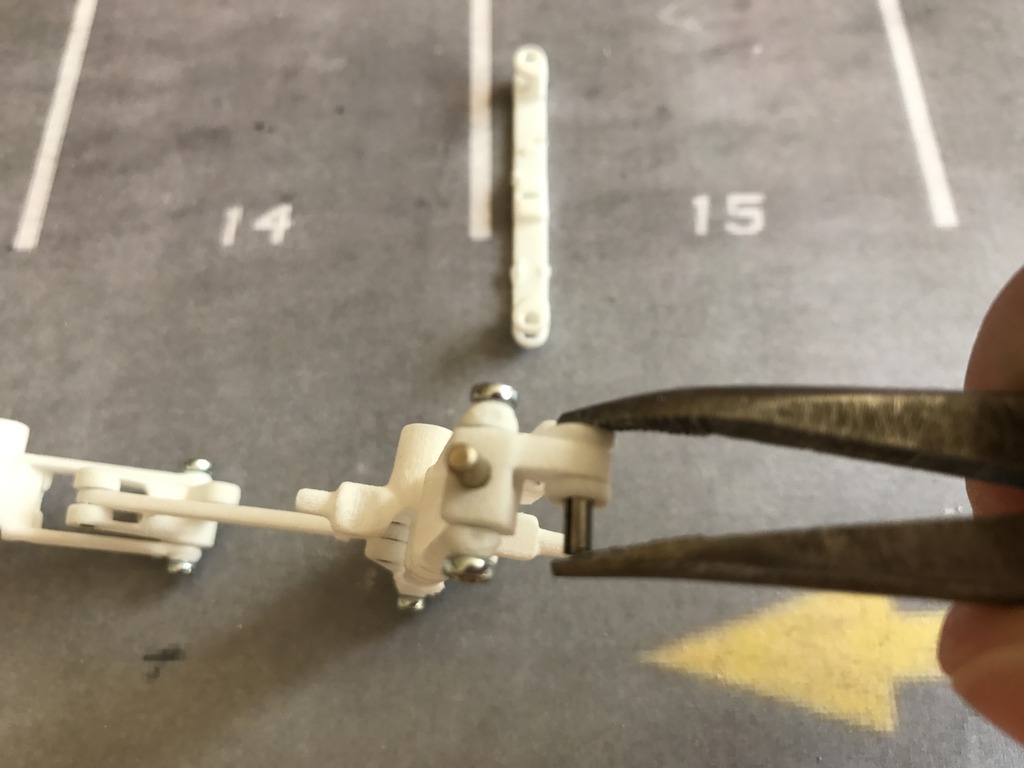
Do the same with the other axle.
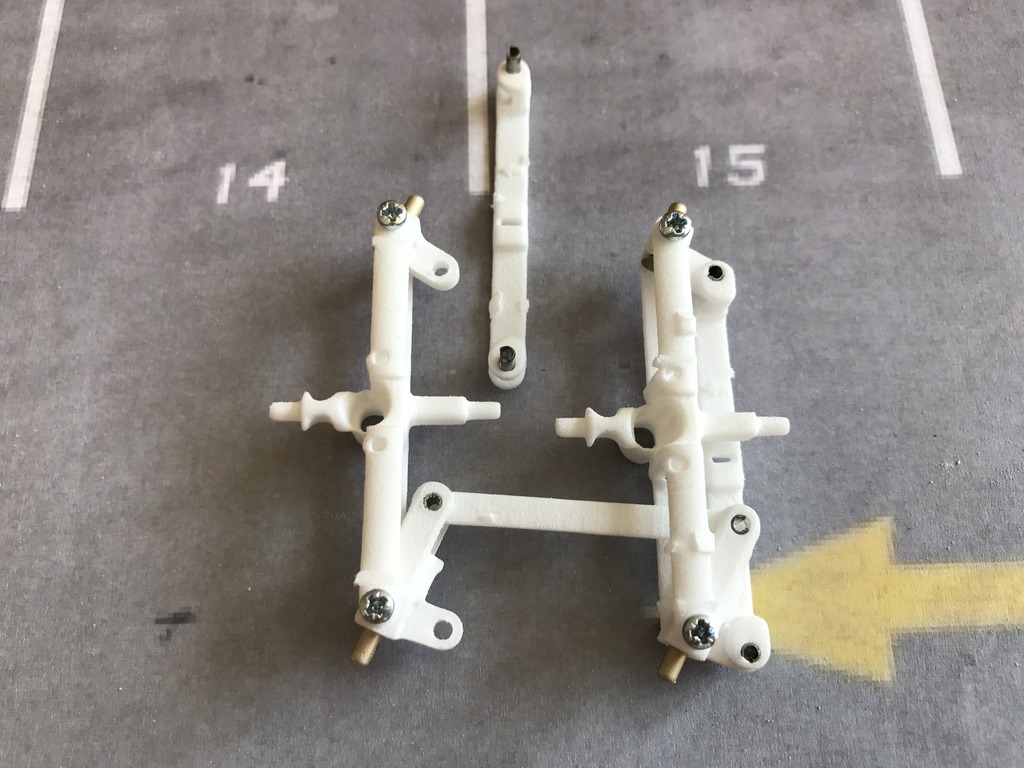
It should all turn smoothly.
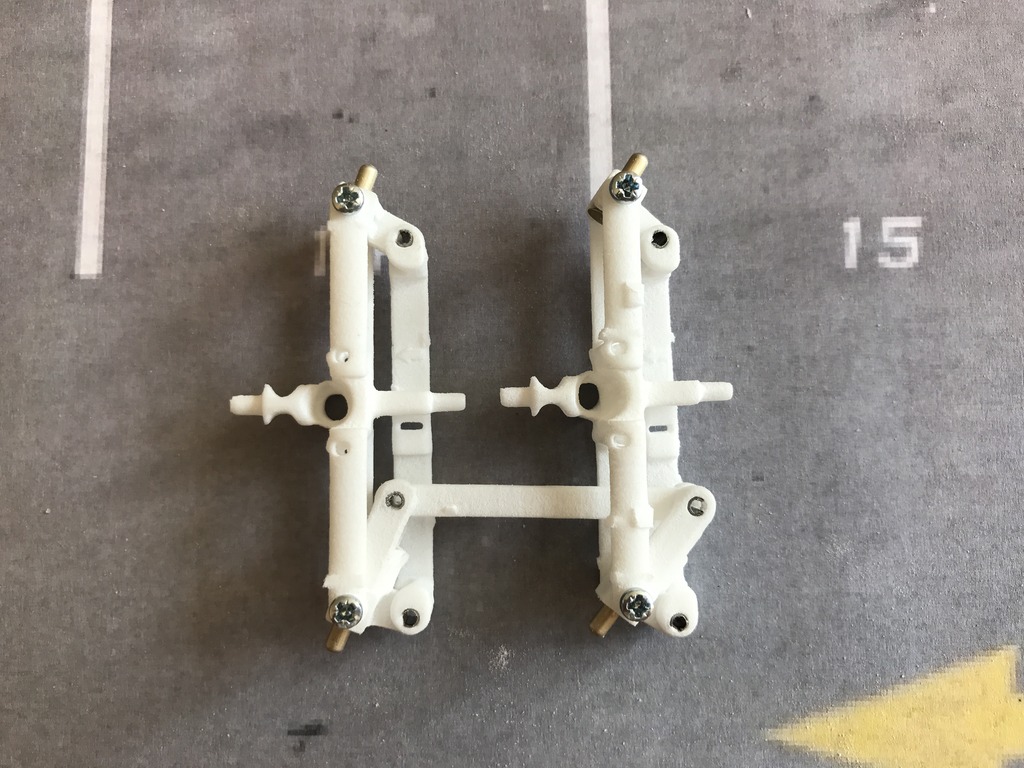
The chassis is the bus floor, it takes the mounts for the front axles like this, with a bearing on either end. They are screwed in place with the longer, thinner screws. The shorter, fatter screws are to hold the bus floor to the bodywork.

The guide is the same as on my other chassis. You need to drill a 1mm hole as shown.
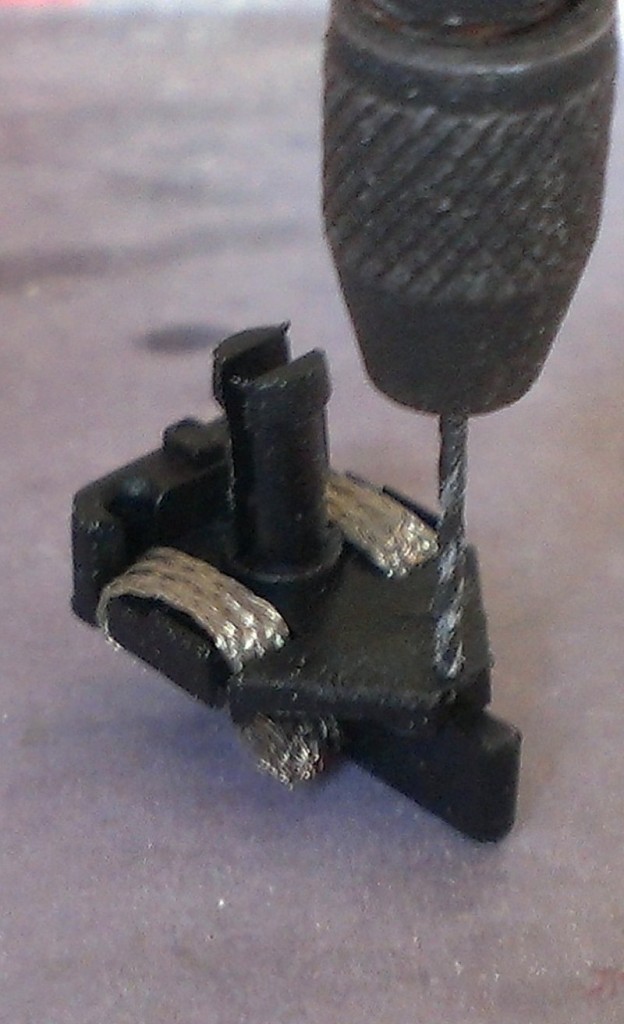
Add a tiny blob of superglue over the hole.
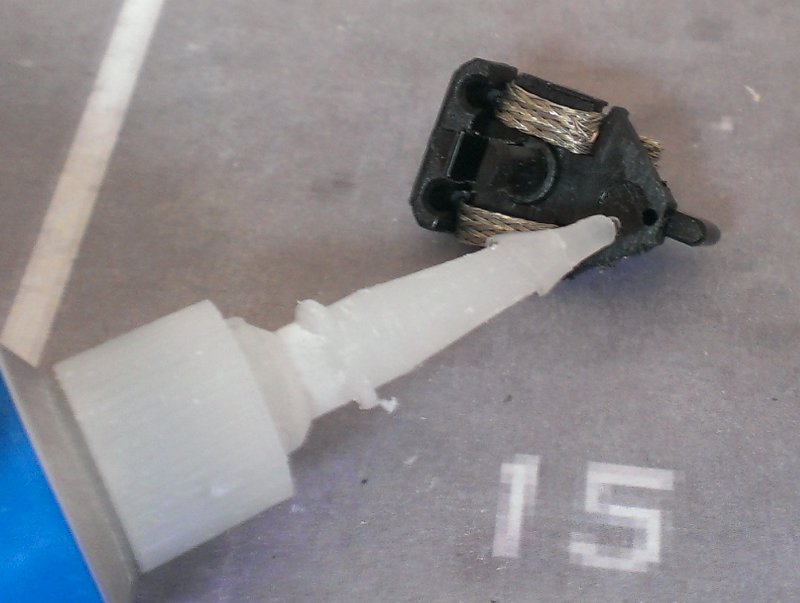
Then push in the 1mm brass bar.
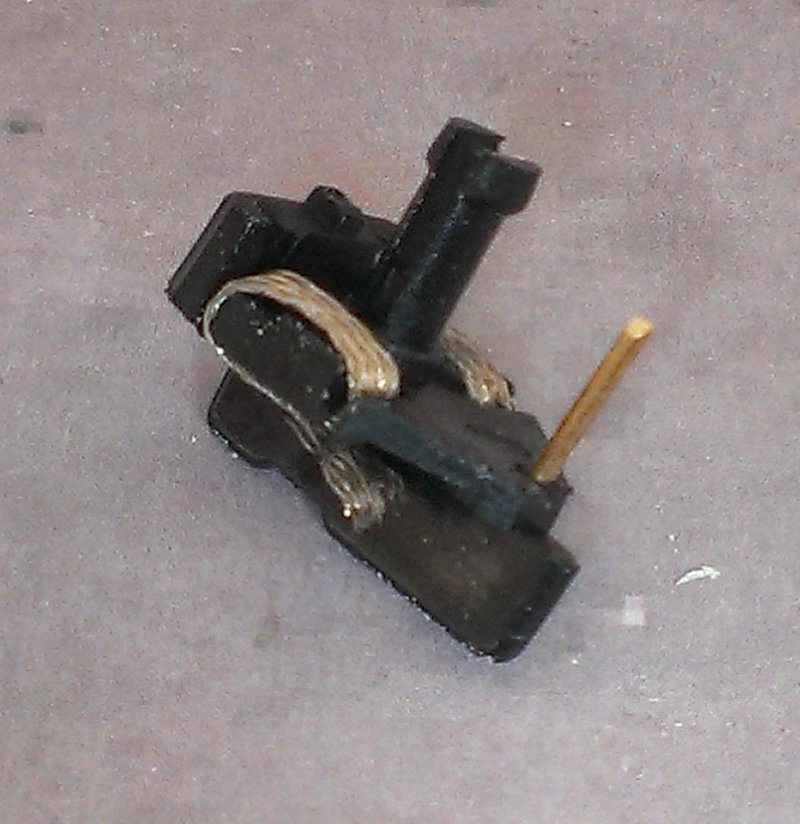
Push it into the Front Axle and check to see how much sticks through the Steering Linkage (this is the car chassis, but the principle is the same)
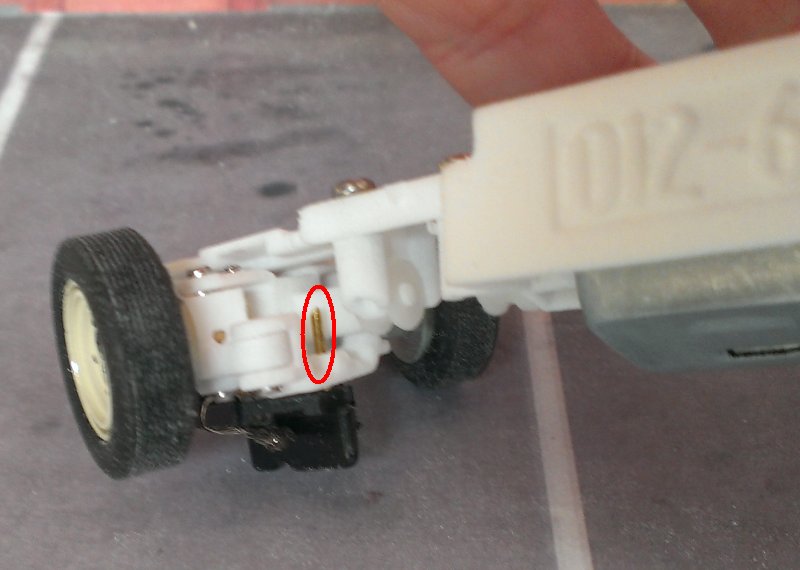
Cut the 1mm brass bar shorter so it just shows through the Steering Linkage.
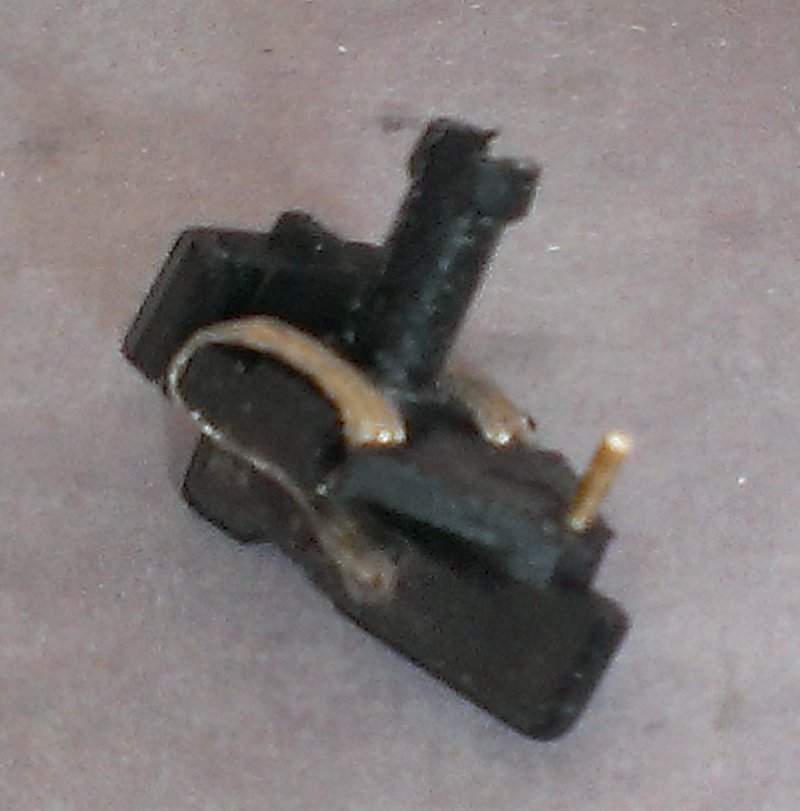
Like this.
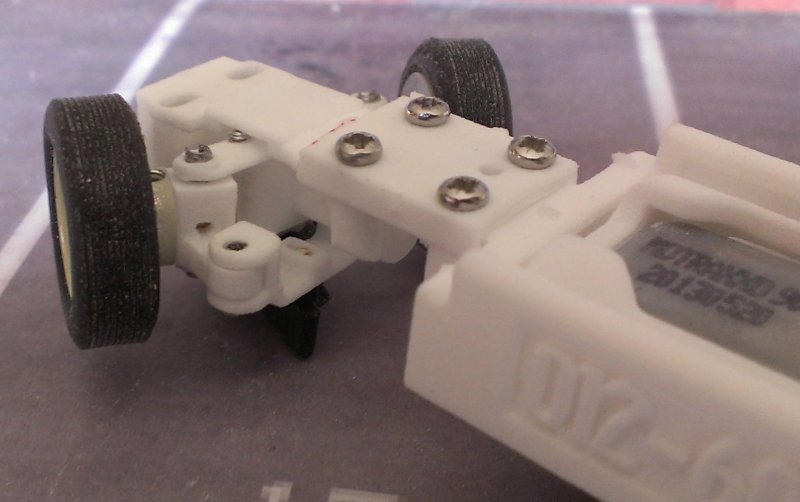
The motor pod attaches to the rear. The bearings and gears fit as shown. Put the long can motor in first, and put the bearings and 2 gears on the shaft/

Rear axle next, put on the contrate gear and bearings.




Pop the wheels off and you can try it for fit into the coach bodywork.

Yes, check everything fits.

It needs a coat of white paint, sanding down and painting white again. If you use wet and dry under a running tap it makes the paper last longer. I use 400 grit on these parts which seems to work well.
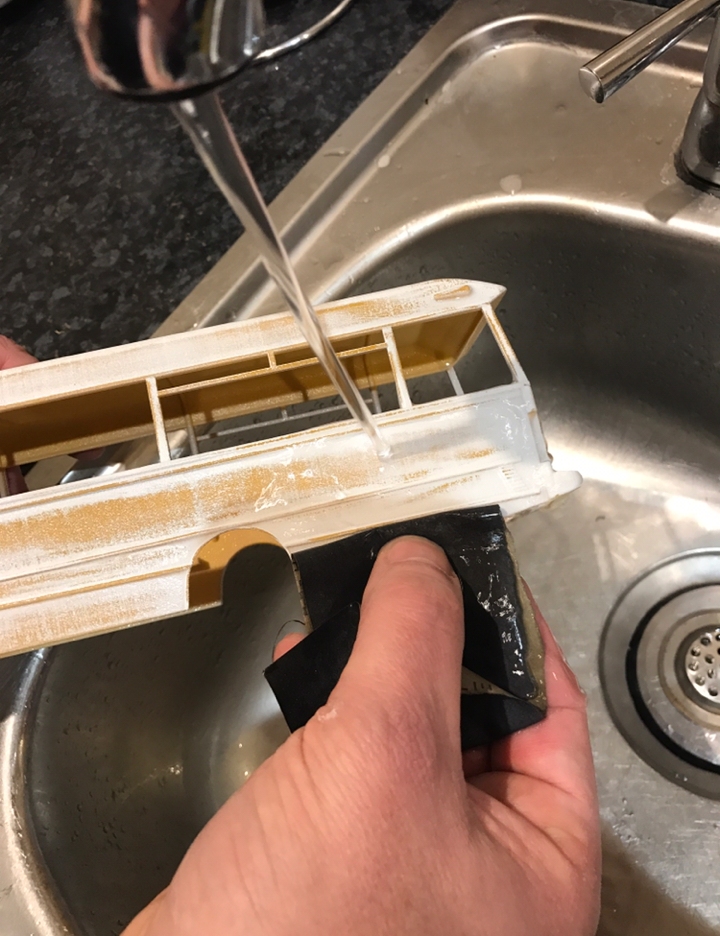
I like Volkswagen Pastel White but you can choose your own shade. Then mask off the roof, the white sides and lay on a mid blue – I used Rover Pageant mid blue. Then mask off everything but the roof and use a deep red, Vauxhall Carmine red was my choice.
The chrome can be filled in with an Edding Paint Pen which cleans up the blurred lines left by the masking tape.

The waterslide graphics are fitted.



Put some clear lacquer on to protect the graphics and the paint, checking the fit again, then put in the windows.

The rear doors hinge with a 1mm brass pin. Leave some sticking out in case you need to remove them later.
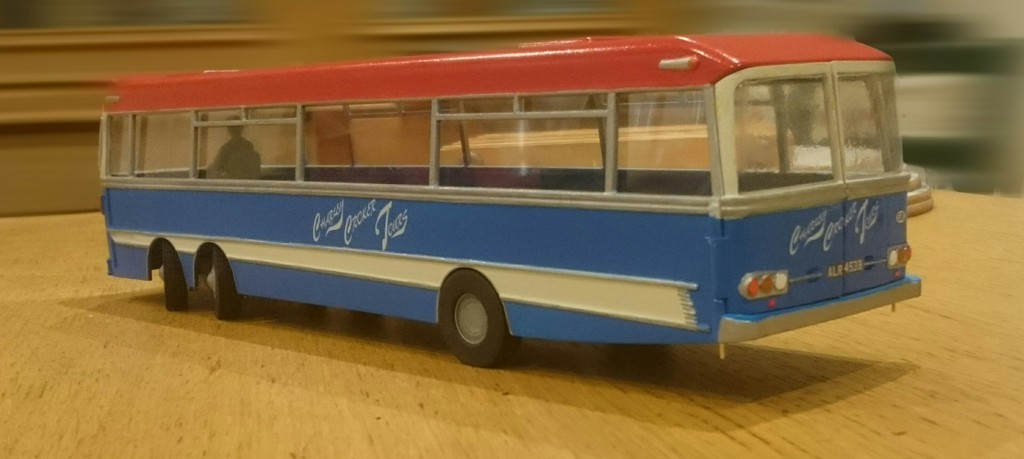
When you screw in the bus floor it can distort the rear a little and affect the fit of the rear doors. Don’t be afraid to loosen the rear screws a little and shim them to suit.
If you want to drive your Minis into the back, you can put some braid or copper tape up into the back.


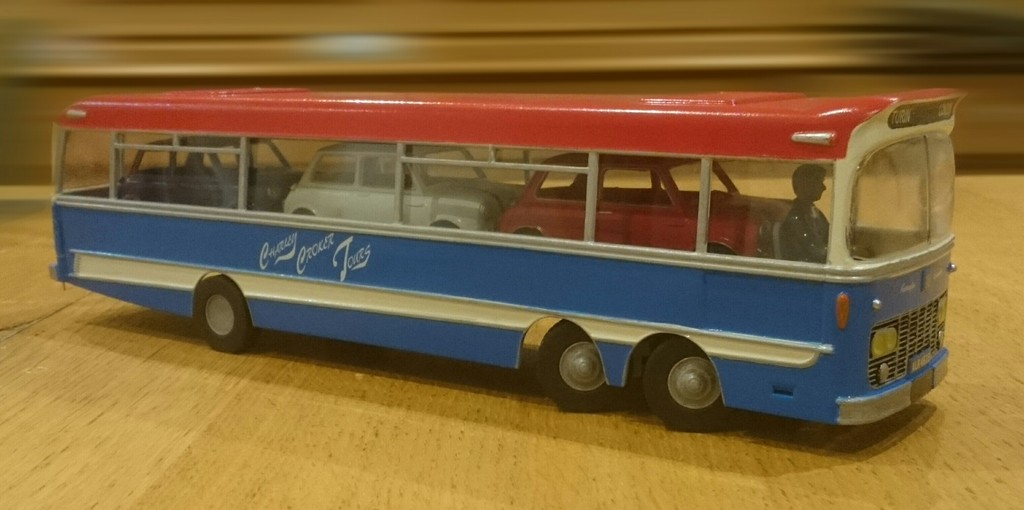
Just be careful of those corners!

A video to inspire you!
